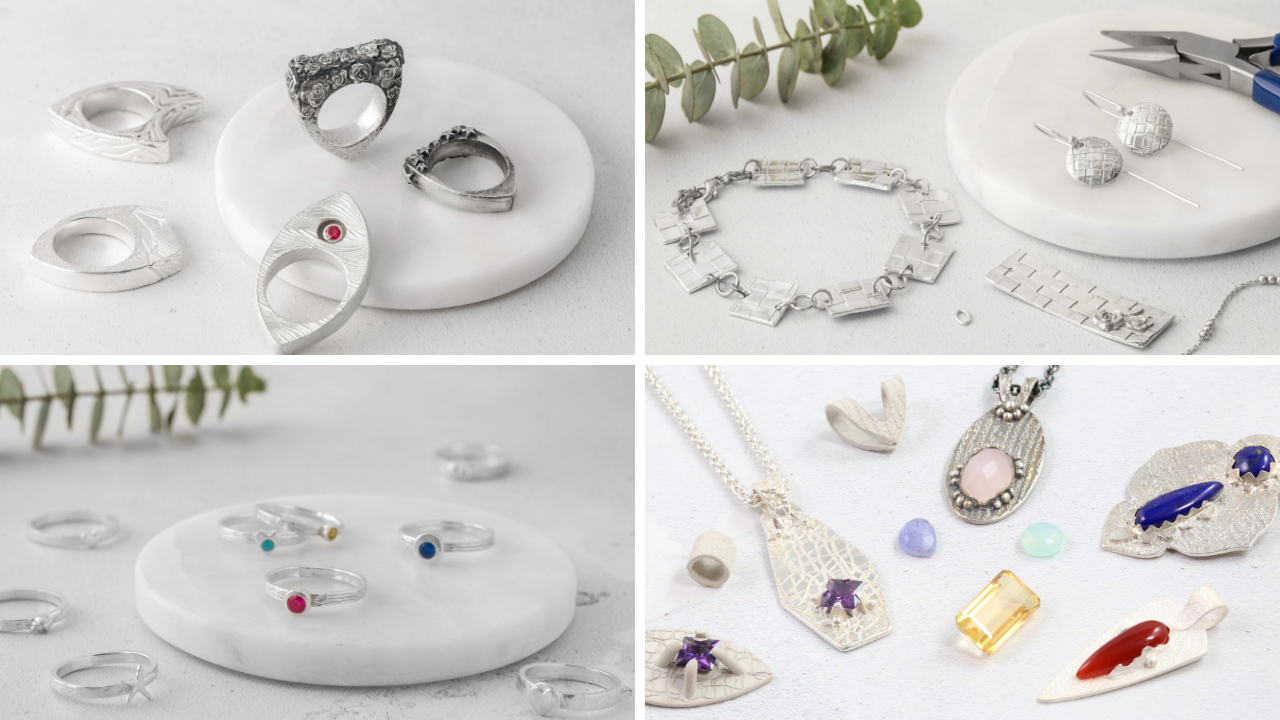A guide to firing gemstones in place with metal clay
If you’re a big fan of working with metal clay and would love to learn more about incorporating gemstones into your designs using the fire in place method, then this handy guide is for you.
Some gemstones can be pressed directly into the clay. Once the clay is dried, it is fired either with a jeweller’s torch or in a kiln. The silver clay sinters into metal and shrinks slightly (around 8 to 10%) and it is the action of shrinking which holds the stone in place.
However, not all gemstones can withstand the heat of the firing required to sinter the metal clay.
Natural gemstones are mined and have natural cuts and fissures in them. When the stone is heated, the heat expands in these cuts and that can cause the stone to crack. Also, some gemstones are heat treated to give them their colour. If you heat them again they lose that lovely colour.
So how do you know which stones to fire in place and which will need to be set another way?
Knowing which gemstones can be fired
There are many gemstones which can be set and fired in place with metal clay. However, there are others which can’t withstand the heat of firing though, so it’s important to know which ones can be fired and leave those that can’t be fired to be set via traditional stone setting methods once your piece has been fired.
The risk of firing gemstones in metal clay
It’s also important to note that there is always a certain degree of risk when firing stones in place. Natural gemstones sometimes have inclusions or internal flaws which can’t been seen, that may in turn affect the stability of the stone when firing. Therefore its important to err on the side of caution if you can’t afford to lose the gemstone you’re working with.
Man-made stones such as Cubic Zirconias are more stable and consistent than natural gemstones, but there is also still a risk of the stone cracking or discolouring if it gets too hot.
One tip is to put any stones you want to test on your firing brick/soldering block and heat them up for 30 seconds to 1 minute. Leave them to cool naturally and once you are sure they are cool, check them carefully. Are they the same colour? Are there any cracks or issues with the stone? It is better to test your stones before you use them in a jewellery design.
How to fire gemstones in metal clay
For the gemstones which can be fired in place with metal clay, we recommend firing your work in a kiln rather than using a jewellers torch. This will ensure the heat is spread evenly across the piece and reduce the risk of damaging your stones.
As the Cool Tools guide below will explain in more detail, some stones respond better when being fired on the open shelf in the kiln, and others are better when carbon fired (this is when the piece is buried in carbon to protect it from oxidisation). Some gemstones can also be torch fired if you are confident in keeping the piece evenly heated.
You should never crash cool your piece once fired with the stone in place - by this we mean putting a hot piece into cold water. Going from hot to cold quickly risks damaging the stone. Leave your piece to cool naturally - it usually only takes around 10 minutes. You can cool it down a little more quickly by placing it on a steel block.
Natural gemstones which can be fired
Whether a gemstone can withstand the heat of firing depends on the unique chemical composition of the stone and the only way of knowing which ones can be fired has been through testing them.
Stones that have been tested and known to withstand firing in metal clay are those such as Labradorite, Moonstone, Ruby, Peridot, Sapphire, Spinel, Tanzanite, Rhodolite Garnet and Zircon.
Gemstones which can’t be fired in place
You will notice that particular types of stones such as those from the Quartz family, cannot be fired. For example, Amethyst, Agate, Black Oynx, Chalcedony, Carnelian and Citrine which are all from the Quartz family can’t be fired. Other types of stones such as Fire Opals, Emeralds and even Diamonds also can’t be fired.
Lab created/man-made gemstones which can be fired
Lab-created Diamonds, Amethysts, Sapphires, Rubys, Spinel and some Topaz can also be fired. And some stones such as Alexandrite, Olivine CZ and Corundrum Citrine can be fired but may darken slightly once fired. See the Cool Tools guide below for more details.
The Cool Tools Guide to fireable gemstones
We highly recommend taking a look at this thorough guide to firing gemstones from Cool Tools. It goes into lots of detail about which gemstones can and can’t be fired, how they should be fired, as well as at what temperature they should be fired.
The list contains those gemstones which have been tested not only by Cool Tools, but also by Rio Grande. If you don’t see the gemstone you wish to fire in place on the list, then we recommend not attempting to fire it.
www.cooltools.us/v/vspfiles/assets/images/Article-Gemstones_In_Metal_Clay.pdf
Of course, if a stone cannot be fired in place it can be set onto your metal clay piece after firing using traditional methods including bezel setting, claw setting, flush setting etc.
The Diploma in Silver Metal Clay
If you would love to learn more about how to make jewellery from this magic material as well as more about how to fire stones in place then do check out our one-year online Diploma in Silver Metal Clay. In this course you are fully supported and learn all about how to set gemstones in metal clay - both fire-in-place and stone-setting techniques after firing.
Click the button below to find out what you could achieve.


